Page 99 of 341
2-29 Shift Speeds
CAUTION:
If you skip a gear when you downshift, you could
lose control of your vehicle. You could injure
yourself or others. Don't shift down more than
one gear at a time when you downshift.
Up-Shift Light (Manual Transaxle) (If Equipped)
If you have a manual
transaxle, you may have a
SHIFT light. This light will
show you when to shift to
the next higher gear for the
best fuel economy.
When this light comes on, you can shift to the next
higher gear if the weather, road and traffic conditions let
you. For the best fuel economy, accelerate slowly and
shift when the light comes on.
Parking Brake
To set the parking brake, hold the regular brake pedal
down with your right foot. Pull up on the parking brake
handle. If the ignition is on, the brake system warning
light will come on.
Page 102 of 341
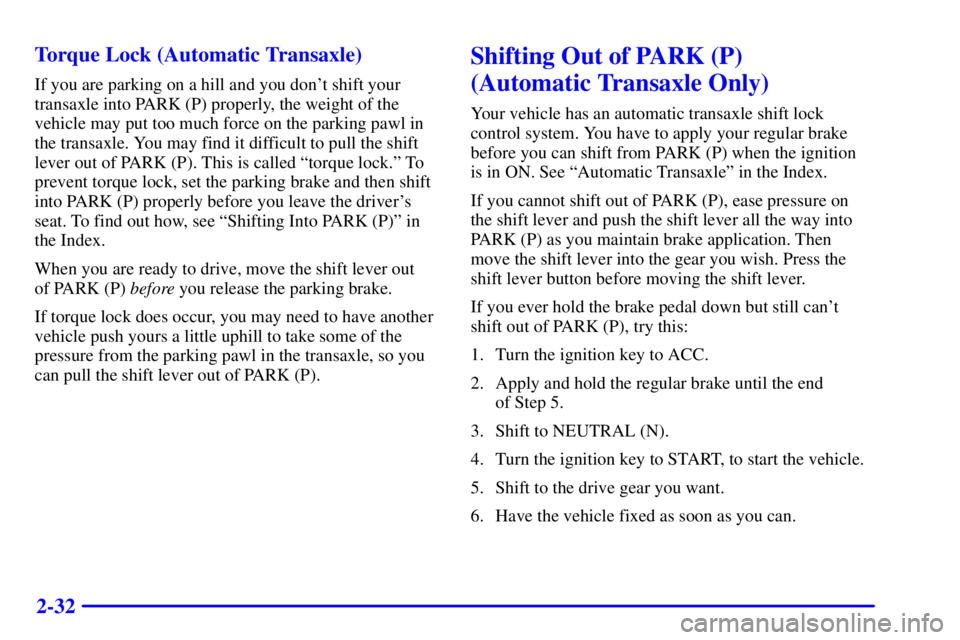
2-32 Torque Lock (Automatic Transaxle)
If you are parking on a hill and you don't shift your
transaxle into PARK (P) properly, the weight of the
vehicle may put too much force on the parking pawl in
the transaxle. You may find it difficult to pull the shift
lever out of PARK (P). This is called ªtorque lock.º To
prevent torque lock, set the parking brake and then shift
into PARK (P) properly before you leave the driver's
seat. To find out how, see ªShifting Into PARK (P)º in
the Index.
When you are ready to drive, move the shift lever out
of PARK (P) before you release the parking brake.
If torque lock does occur, you may need to have another
vehicle push yours a little uphill to take some of the
pressure from the parking pawl in the transaxle, so you
can pull the shift lever out of PARK (P).
Shifting Out of PARK (P)
(Automatic Transaxle Only)
Your vehicle has an automatic transaxle shift lock
control system. You have to apply your regular brake
before you can shift from PARK (P) when the ignition
is in ON. See ªAutomatic Transaxleº in the Index.
If you cannot shift out of PARK (P), ease pressure on
the shift lever and push the shift lever all the way into
PARK (P) as you maintain brake application. Then
move the shift lever into the gear you wish. Press the
shift lever button before moving the shift lever.
If you ever hold the brake pedal down but still can't
shift out of PARK (P), try this:
1. Turn the ignition key to ACC.
2. Apply and hold the regular brake until the end
of Step 5.
3. Shift to NEUTRAL (N).
4. Turn the ignition key to START, to start the vehicle.
5. Shift to the drive gear you want.
6. Have the vehicle fixed as soon as you can.
Page 104 of 341
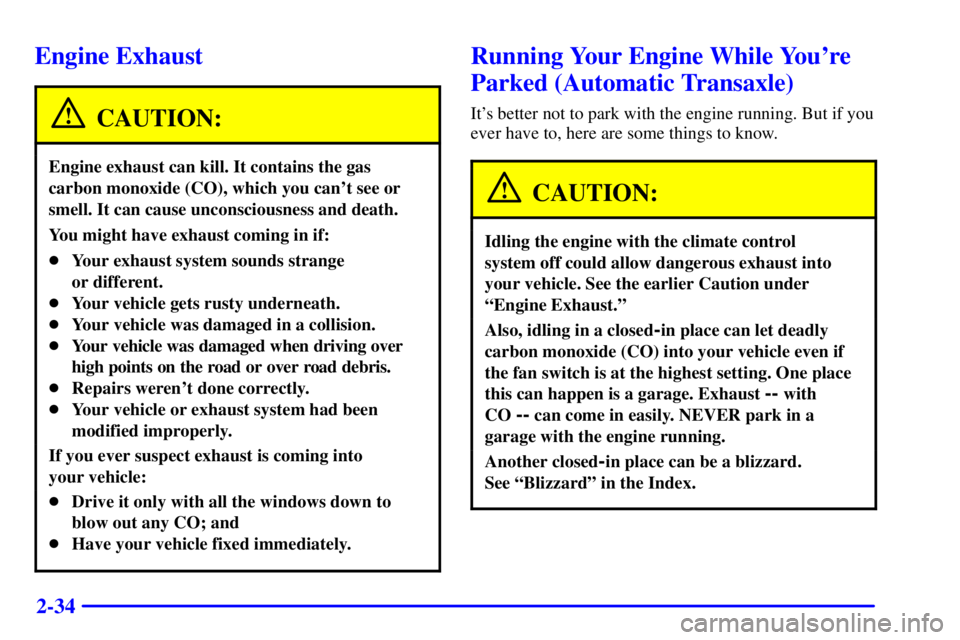
2-34
Engine Exhaust
CAUTION:
Engine exhaust can kill. It contains the gas
carbon monoxide (CO), which you can't see or
smell. It can cause unconsciousness and death.
You might have exhaust coming in if:
�Your exhaust system sounds strange
or different.
�Your vehicle gets rusty underneath.
�Your vehicle was damaged in a collision.
�Your vehicle was damaged when driving over
high points on the road or over road debris.
�Repairs weren't done correctly.
�Your vehicle or exhaust system had been
modified improperly.
If you ever suspect exhaust is coming into
your vehicle:
�Drive it only with all the windows down to
blow out any CO; and
�Have your vehicle fixed immediately.
Running Your Engine While You're
Parked (Automatic Transaxle)
It's better not to park with the engine running. But if you
ever have to, here are some things to know.
CAUTION:
Idling the engine with the climate control
system off could allow dangerous exhaust into
your vehicle. See the earlier Caution under
ªEngine Exhaust.º
Also, idling in a closed-in place can let deadly
carbon monoxide (CO) into your vehicle even if
the fan switch is at the highest setting. One place
this can happen is a garage. Exhaust
-- with
CO
-- can come in easily. NEVER park in a
garage with the engine running.
Another closed-in place can be a blizzard.
See ªBlizzardº in the Index.
Page 106 of 341
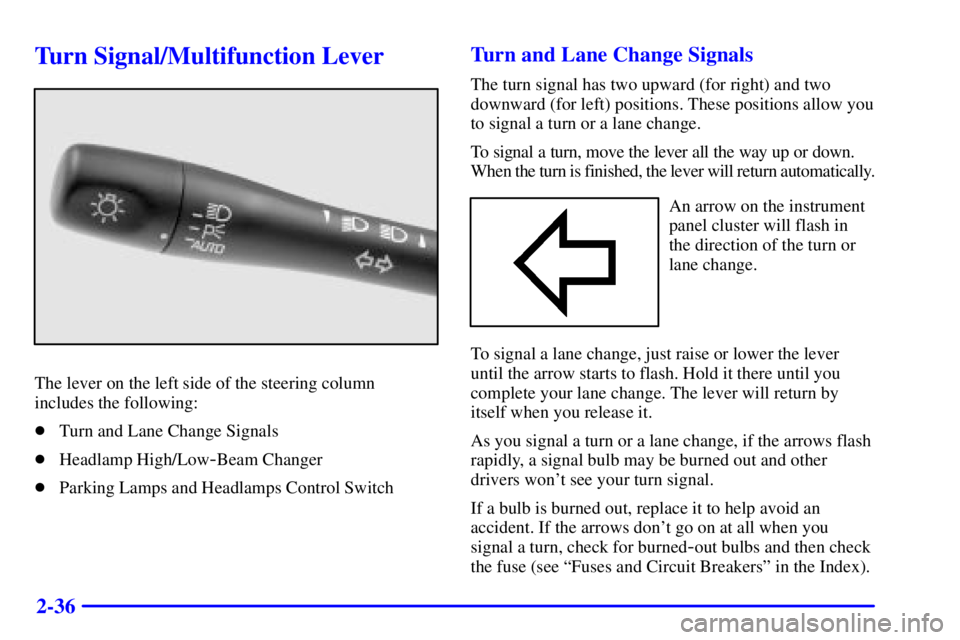
2-36
Turn Signal/Multifunction Lever
The lever on the left side of the steering column
includes the following:
�Turn and Lane Change Signals
�Headlamp High/Low
-Beam Changer
�Parking Lamps and Headlamps Control Switch
Turn and Lane Change Signals
The turn signal has two upward (for right) and two
downward (for left) positions. These positions allow you
to signal a turn or a lane change.
To signal a turn, move the lever all the way up or down.
When the turn is finished, the lever will return automatically.
An arrow on the instrument
panel cluster will flash in
the direction of the turn or
lane change.
To signal a lane change, just raise or lower the lever
until the arrow starts to flash. Hold it there until you
complete your lane change. The lever will return by
itself when you release it.
As you signal a turn or a lane change, if the arrows flash
rapidly, a signal bulb may be burned out and other
drivers won't see your turn signal.
If a bulb is burned out, replace it to help avoid an
accident. If the arrows don't go on at all when you
signal a turn, check for burned
-out bulbs and then check
the fuse (see ªFuses and Circuit Breakersº in the Index).
Page 107 of 341
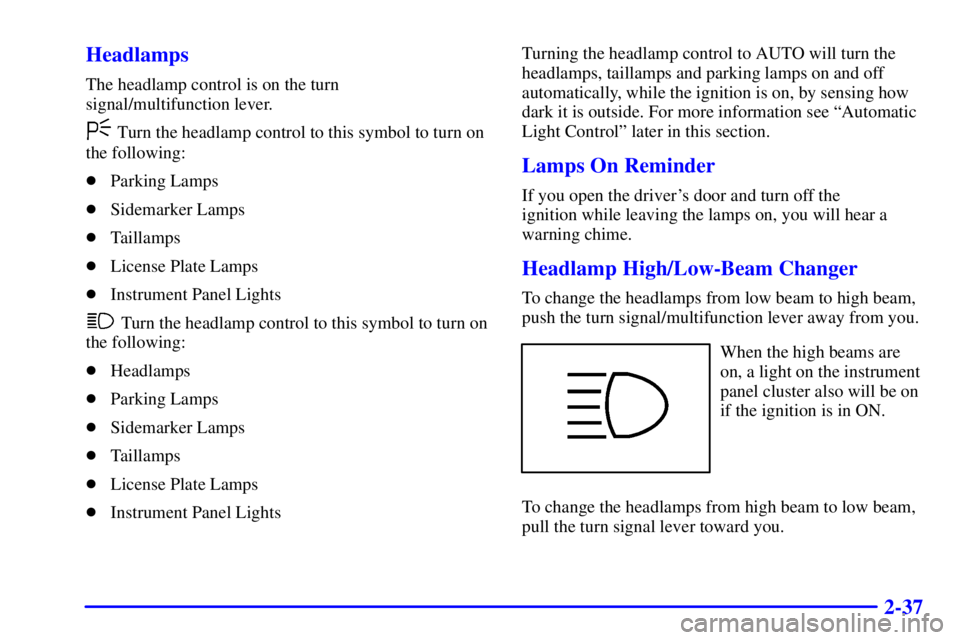
2-37 Headlamps
The headlamp control is on the turn
signal/multifunction lever.
Turn the headlamp control to this symbol to turn on
the following:
�Parking Lamps
�Sidemarker Lamps
�Taillamps
�License Plate Lamps
�Instrument Panel Lights
Turn the headlamp control to this symbol to turn on
the following:
�Headlamps
�Parking Lamps
�Sidemarker Lamps
�Taillamps
�License Plate Lamps
�Instrument Panel LightsTurning the headlamp control to AUTO will turn the
headlamps, taillamps and parking lamps on and off
automatically, while the ignition is on, by sensing how
dark it is outside. For more information see ªAutomatic
Light Controlº later in this section.
Lamps On Reminder
If you open the driver's door and turn off the
ignition while leaving the lamps on, you will hear a
warning chime.
Headlamp High/Low-Beam Changer
To change the headlamps from low beam to high beam,
push the turn signal/multifunction lever away from you.
When the high beams are
on, a light on the instrument
panel cluster also will be on
if the ignition is in ON.
To change the headlamps from high beam to low beam,
pull the turn signal lever toward you.
Page 108 of 341
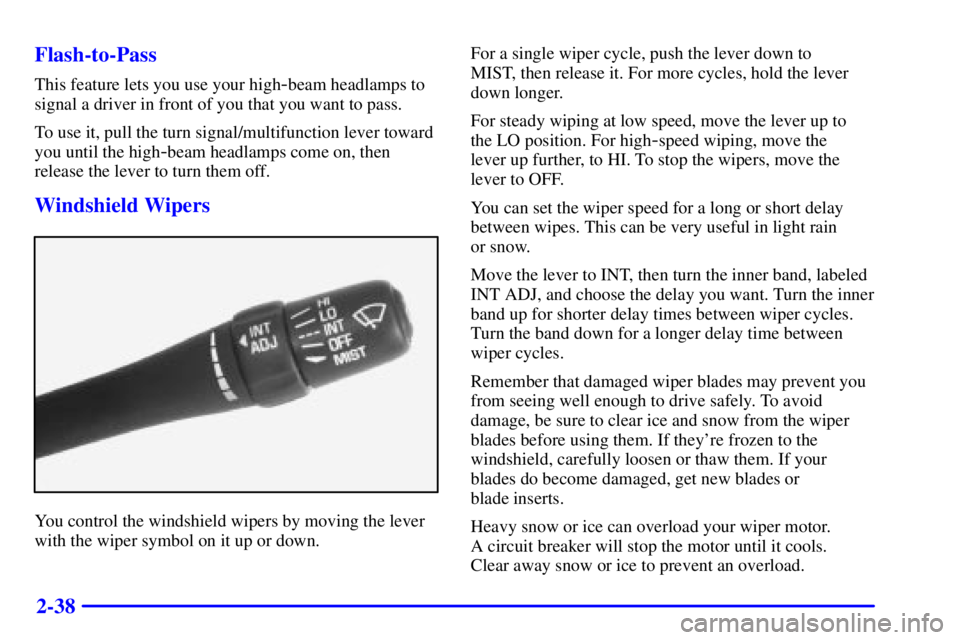
2-38 Flash-to-Pass
This feature lets you use your high-beam headlamps to
signal a driver in front of you that you want to pass.
To use it, pull the turn signal/multifunction lever toward
you until the high
-beam headlamps come on, then
release the lever to turn them off.
Windshield Wipers
You control the windshield wipers by moving the lever
with the wiper symbol on it up or down.For a single wiper cycle, push the lever down to
MIST, then release it. For more cycles, hold the lever
down longer.
For steady wiping at low speed, move the lever up to
the LO position. For high
-speed wiping, move the
lever up further, to HI. To stop the wipers, move the
lever to OFF.
You can set the wiper speed for a long or short delay
between wipes. This can be very useful in light rain
or snow.
Move the lever to INT, then turn the inner band, labeled
INT ADJ, and choose the delay you want. Turn the inner
band up for shorter delay times between wiper cycles.
Turn the band down for a longer delay time between
wiper cycles.
Remember that damaged wiper blades may prevent you
from seeing well enough to drive safely. To avoid
damage, be sure to clear ice and snow from the wiper
blades before using them. If they're frozen to the
windshield, carefully loosen or thaw them. If your
blades do become damaged, get new blades or
blade inserts.
Heavy snow or ice can overload your wiper motor.
A circuit breaker will stop the motor until it cools.
Clear away snow or ice to prevent an overload.
Page 109 of 341
2-39 Windshield Washer
To wash your windshield, push in the button at the end
of the stalk until the washers begin.
CAUTION:
In freezing weather, don't use your washer until
the windshield is warmed. Otherwise the washer
fluid can form ice on the windshield, blocking
your vision.
When you release the button, the washers will stop, but
the wipers will continue to wipe for about three times or
will resume the speed you were using before.
Cruise Control (If Equipped)
The cruise control buttons are located on the bottom of
the steering wheel.
With cruise control, you can maintain a speed of about
25 mph (40 km/h) or more without keeping your foot
on the accelerator. This can really help on long trips.
Cruise control does not work at speeds below
25 mph (40 km/h).
Page 110 of 341
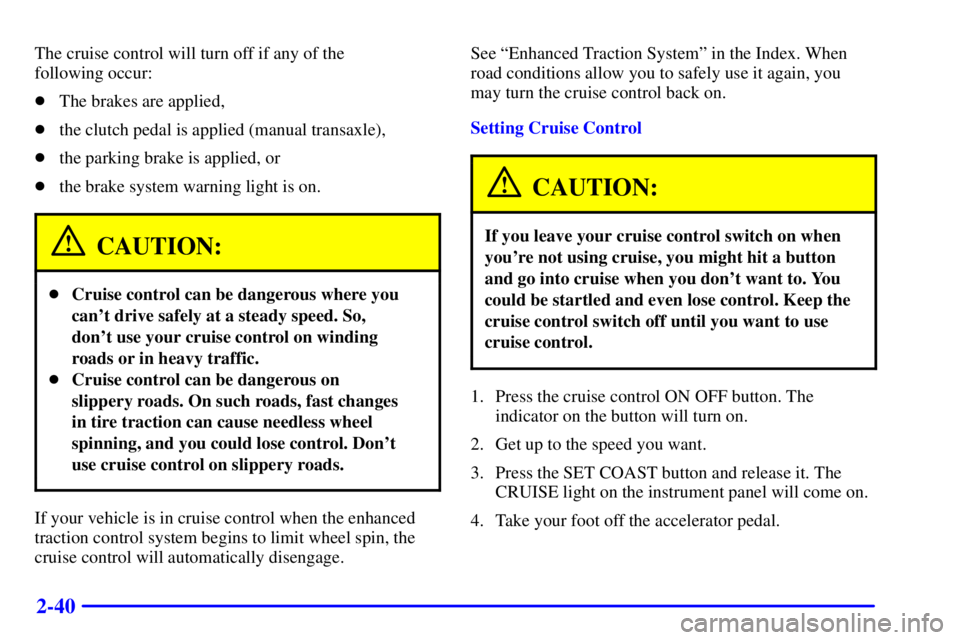
2-40
The cruise control will turn off if any of the
following occur:
�The brakes are applied,
�the clutch pedal is applied (manual transaxle),
�the parking brake is applied, or
�the brake system warning light is on.
CAUTION:
�Cruise control can be dangerous where you
can't drive safely at a steady speed. So,
don't use your cruise control on winding
roads or in heavy traffic.
�Cruise control can be dangerous on
slippery roads. On such roads, fast changes
in tire traction can cause needless wheel
spinning, and you could lose control. Don't
use cruise control on slippery roads.
If your vehicle is in cruise control when the enhanced
traction control system begins to limit wheel spin, the
cruise control will automatically disengage.See ªEnhanced Traction Systemº in the Index. When
road conditions allow you to safely use it again, you
may turn the cruise control back on.
Setting Cruise Control
CAUTION:
If you leave your cruise control switch on when
you're not using cruise, you might hit a button
and go into cruise when you don't want to. You
could be startled and even lose control. Keep the
cruise control switch off until you want to use
cruise control.
1. Press the cruise control ON OFF button. The
indicator on the button will turn on.
2. Get up to the speed you want.
3. Press the SET COAST button and release it. The
CRUISE light on the instrument panel will come on.
4. Take your foot off the accelerator pedal.